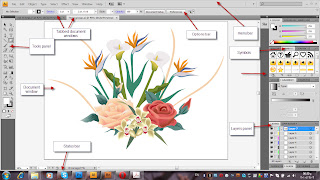Nondestructive editing allows you to make changes to an image without overwriting the original image data, which remains available in case you want to revert to it. Because nondestructive editing doesn’t remove data from an image, the image quality doesn’t degrade when you make edits.
Ways of Nondestructive editing :
- Working with adjustment layers: Adjustment layers apply color and tonal adjustments to an image without permanently changing pixel values.
- Transforming with Smart Objects: Smart Objects enable nondestructive scaling, rotating, and warping.
- Retouching on a separate layer: Clone Stamp, Healing Brush, and Spot Healing Brush tools let you retouch non-destructively on a separate layer. Be sure to select Sample All Layers from the options bar (select Ignore Adjustment Layers to ensure that adjustment layers won’t affect the separate layer twice). You can discard unsatisfactory retouching, if necessary.
- Filtering with Smart Filters: Filters applied to Smart Objects become Smart Filters and allow for nondestructive filter effects.
- Masking Layer and vector masks : are nondestructive because you can re-edit the masks without losing the pixels they hide. Filter masks let you mask out the effects of Smart Filters on Smart Object layers.
- Adjusting variations, shadows, and highlights with Smart Objects: Shadow/Highlight and Variations commands can be applied to a Smart Object as Smart Filters.
- Cropping non-destructively: After you create a cropping rectangle with the Crop tool, select Hide from the options bar to preserve the cropped area in a layer. Restore the cropped area anytime by choosing Image > Reveal All or by dragging the Crop tool beyond the edge of the image. The Hide option is unavailable for images that contain only a background layer.
That is how you can edit your photos non-destructively. I will explain more in the next post.
Thanks
MR
تحرير الصور بطرق غير إتلافية يسمح لك بإجراء تغييرات على صورة دون الكتابة فوق بيانات الصورة الأصلية، والتي لا تزال متوفرة فإذا كنت تريد أن إستعادة الصوره الأصليه يمكنك هذا. وهذا التحرير الغير تدميري لا يزيل بيانات الصورة و لا يغيرها ،كما أن جودة الصورة لا تتدهور عند إجراء التعديلات.
تحرير الصور قد يكون بطرق تدميريه و اتلافيه و قد لا تستطيع استعادة الصوره الأصليه مره اخرى و لهذا اقدم لكم طرق حمايه الصور اثناء تناولها بالفوتوشوب.
ملاحظه هامه
أولا و قبل أى شئ احفظ الصوره فى ملف آخر و بإسم آخر فتكون فى مأمن من التلف .
طرق التحرير الغير تدميرى للصور بالفوتوشوب :
أولا :
العمل مع طبقات التعديل Adjustments Layers:
طبقات التعديل تقوم تطبيق لون وتعديلات الدرجات اللونية على الصورة من دون تغيير قيم البكسل بطريقه دائمة .
ثانيا :
تحويل الكائنات الى كائنات ذكية Smart Objects:
فالكائنات الذكية تمكن من التحجيم ( تغيير الحجمscaling) ، و الإستداره(rotating) ، والالتواء(warping) , و غيرها بطرق غير تدميريه.
ثالثا :
يجب ان يكون التصحيح على طبقة منفصلة :
مثلا فى حالة استعمال اداة ختم النسخ clone stamp tool،
و اداة فرشاة المداواة healing brush tool،
وأداة الفرشاة الفوريه spot healing tool
تمكنك من تنميق و تهذيب الغير المدمر على طبقة منفصلة. تأكد من تحديد اختر كل الطبقات في شريط الخيارات .
رابعا :
استمعال الفلاتر او المرشحات الذكية smart filters :
إستعمال طبقات الأقنعه (layer mask ) والاقنعة الواقية غير تدميريه لأنه يمكنك إعادة تحرير الأقنعة الواقية من دون أن تفقد البكسلات المخفيه.
خامسا :
استعمال أقنعة المرشحات ( filter mask) .
سادسا :
الاقتصاص الغير مدمر( crop) :
بعد إنشاء مستطيل الاقتصاص بأداة الإقتصاص، حدد إخفاء ( hide)من شريط الخيارات للحفاظ على مساحة الصوره كامله في طبقة فنقوم بإخفائها بدلا من اقتصاصها و فقدها نهائيا .
و هكذا يمكننا استعادة المساحة المقطوعة في أي وقت عن طريق اختيار صورة> الكشف عن جميع ( reveal all)أو عن طريق سحب أداة اقتصاص ما وراء حافة الصورة.
إذا لم كان خيار( hide) غير متوفر فى شريط الخيارات فإعلم انك تعمل على طبقة الخلفية.
هذه بعض النقاط الهامه و سوف اضيف فيديو




























